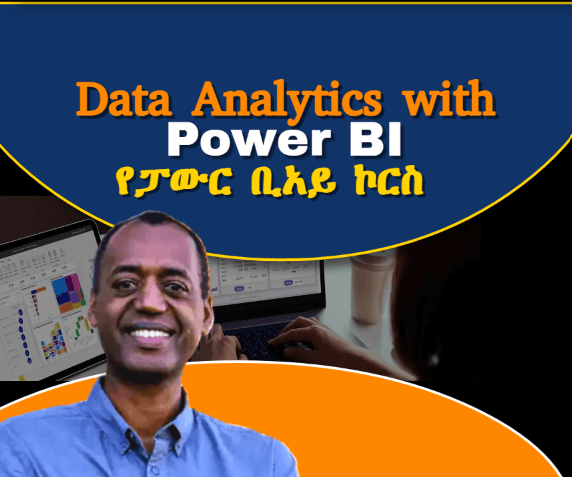Power BI Data Analyst Professional Course in Amharic for Ethiopians
in Microsoft TechsWhat you will learn?
Proficiency in Power BI: Gain a comprehensive understanding of Power BI and its features.
Data Modeling and Transformation: Learn to import, shape, and model data from various sources.
DAX (Data Analysis Expressions): Master the formula language used in Power BI for calculations.
Data Analysis and Reporting: Apply advanced filtering, calculations, and aggregations for analysis.
Advanced Features and Integration: Explore advanced modeling, visuals, and integration with other tools.
Real-World Projects and Case Studies: Apply skills to solve practical data analysis challenges.
Power Query: Gain proficiency in Power Query, a powerful data transformation tool in Power BI. Learn advanced data cleansing and shaping techniques, handling complex data structures, and implementing data loading strategies.
Power BI Dataflows: Understand how to leverage Power BI Dataflows to create reusable and scalable data preparation processes. Learn to build dataflows, manage entities, and schedule data refreshes to ensure data consistency and efficiency.
Advanced DAX Calculations: Dive deeper into DAX expressions to perform advanced calculations and create complex measures and calculations using functions like CALCULATE, FILTER, and iterating functions such as SUMX and AVERAGEX.
Performance Optimization: Learn techniques to optimize the performance of Power BI solutions, such as optimizing data models, improving query performance, and reducing report load times.
Advanced Analytics: Explore advanced analytical capabilities in Power BI, including integrating statistical functions, using forecasting techniques, implementing clustering algorithms, and leveraging the integration with Azure Machine Learning.
Governance and Security: Understand the best practices for implementing governance and security measures in Power BI, including managing access rights, implementing row-level security, and applying data classification and sensitivity labels.
Integration with Azure Services: Learn how to integrate Power BI with other Azure services such as Azure Data Factory, Azure Analysis Services, and Azure Synapse Analytics to create end-to-end data solutions.
Receive a certificate of completion, demonstrating your expertise in Power BI Data Analysis
About this course
mso-font-kerning:0pt;mso-ligatures:none">The Microsoft Power BI Data Analyst On-demand
Training
mso-fareast-font-family:"Times New Roman";mso-font-kerning:0pt;mso-ligatures:
none">is a comprehensive program designed to equip participants with advanced
skills and knowledge in utilizing Power BI for data analysis and visualization.
The course covers both foundational and advanced concepts to enhance
participants' proficiency in Power BI.
"Times New Roman";mso-font-kerning:0pt;mso-ligatures:none">
"Times New Roman";mso-font-kerning:0pt;mso-ligatures:none">Recommended Time
Investment
"Times New Roman";mso-font-kerning:0pt;mso-ligatures:none">4-5 hours per week
for 8-10 weeks
mso-font-kerning:0pt;mso-ligatures:none">
mso-font-kerning:0pt;mso-ligatures:none">Language of instruction: Amharic
mso-font-kerning:0pt;mso-ligatures:none">
mso-font-kerning:0pt;mso-ligatures:none">While the course material is prepared
in English, the trainer will use Amharic language for in-depth
explanation of concepts
mso-fareast-font-family:"Times New Roman";mso-bidi-font-family:"Times New Roman";
mso-font-kerning:0pt;mso-ligatures:none">.
mso-fareast-font-family:"Times New Roman";mso-font-kerning:0pt;mso-ligatures:
none">
mso-font-kerning:0pt;mso-ligatures:none">
"Times New Roman";mso-font-kerning:0pt;mso-ligatures:none">Skills you will
learn
mso-font-kerning:0pt;mso-ligatures:none">
mso-font-kerning:0pt;mso-ligatures:none">The training begins with an
introduction to Power BI and its key components. Participants will learn how to
import data from various sources and use Power Query Editor for advanced data
transformations. They will also explore advanced data modeling techniques,
including creating calculated tables, implementing advanced relationships, and
handling complex data scenarios.
mso-font-kerning:0pt;mso-ligatures:none">
mso-font-kerning:0pt;mso-ligatures:none">As the training progresses,
participants will delve into advanced visualization techniques, including the
use of custom visuals and advanced formatting options. They will learn how to
create highly interactive and visually appealing reports and dashboards,
enabling them to effectively convey insights from their data.
mso-font-kerning:0pt;mso-ligatures:none">
mso-fareast-font-family:"Times New Roman";mso-font-kerning:0pt;mso-ligatures:
none;mso-ansi-language:EN-US;mso-fareast-language:EN-US;mso-bidi-language:AR-SA">Additionally,
the training covers advanced concepts such as DAX (Data Analysis Expressions),
the formula language used in Power BI. Participants will gain proficiency in
writing complex DAX expressions to perform calculations, create measures, and
implement advanced calculations for in-depth data analysis.
Requirements
Basic computer skills
Reliable internet connection for attending live class sessions
Willingness to actively participate and engage in the training
Related Courses
FAQ
Comments (4)

When going to be new class begin. Bogalech Helato

Hi Bogalech,
We're starting the Live training on March 5, 2024. If you have any questions, just let us know. Thanks!

I recently had the pleasure of attending Microsoft Power BI Data Analyst Professional Live Training Course by Dr. Bereket , and I must say it was an absolute game changer. Dr. Bereket's expertise in Power BI is truly unparalleled - he provided clear and concise explanations, making even the most complex concepts like Power BI DAX, easy to understand. The hands-on exercises and real-world examples helped solidify my knowledge, ensuring that I could immediately apply what I learned in my work. If you're looking for top-notch Microsoft Power BI Data Analyst training that will truly elevate your skills, look no further than Ardiland Institute of Technology and Dr. Bereket Philipos.

Thank you!🙏

Is there going to orientation. before August 8.?
Hi Anchinesh - yes there will be an overview session open to everyone. It will be on Sunday July 23rd at 9PM eastern time.
We will post the link here within the next day.
Thanks!
In this lesson we will introduce the course
Installing Power BI Desktop
Introduction to business intelligence
In this lesson we discuss the 5 types of data analytics:
Descriptive Analytics
Diagnostic Analytics
Predictive Analytics
Prescriptive Analytics
Cognitive Analytics
• Introduction to Power BI: Power BI and its key features
• Overview of the Power BI ecosystem: Power BI Desktop, Power BI Service (Power BI online), and Power BI Mobile
• Exploring the capabilities and benefits of Power BI for data analysis and visualization
• Understanding the role of Power BI in business intelligence and decision-making processes
• Introduction to Power BI Desktop: Layout and key components
• Understanding the different panes and their functions: Report view, Data view, Fields pane, Visualizations pane, and Filters pane
• Exploring the various options in the Power BI ribbon: Home, Modeling, View, and Format tabs
• Working with multiple views: Report view, Data view, and Relationship view
• Introduction to data sources in Power BI: Supported file types and databases
• Connecting to local and cloud-based data sources
• Importing data from CSV files: Configuring delimiter settings and handling data formatting
For this lesson we will use the miles per gallon (mpg) dataset available at https://raw.githubusercontent.com/bpkindo/datasets/main/mpg.csv
Basic DAX Formulas
Importing data from excel to Power BI Desktop.
The data we use for this data is the AdventureWorks sample data available at https://github.com/bpkindo/datasets
Installing SQL Server, SQL Server Management Studio and AdventureWorks sample database
• Introduction to the integration between Power BI and SQL Server: Benefits and scenarios
• Connecting Power BI to SQL Server: Importing data from SQL Server databases
Often relational databases contain large amount of data that it may not be appropriate to import the entire table to Power BI. In such cases, we summarize data using SQL code, utilize the advanced option to import data to Power BI
- DirectQuery in Power BI: Configuring DirectQuery mode and utilizing SQL Server as a DirectQuery source
- Understanding performance considerations and limitations
- When to use DirectQuery and Import
• Importing data from various sources: Databases, web, SharePoint, and other data connectors
Data link: https://en.wikipedia.org/wiki/List_of_states_and_territories_of_the_United_States
SQL programming language is one of the most widely used languages in data analytics. This exercise gives you a very brief overview of few of the most commonly used SQL clauses.
Exploring the Power Query Editor interface: Query settings, query steps, and applied transformations
Data link: https://raw.githubusercontent.com/bpkindo/datasets/main/DSD_PTD_RY24_P04_V10_DY22_BGM.csv
Hands on exercise cleaning and merging data using Power Query Editor
Continue learning the data cleaning capabilities of Power Query Editor
Replacing Values, Filling Values, and Unpivoting
In this lesson we will learn how to combine multiple queries/tables into one by appending them with each other
Data analysis often requires joining one table to another one. In this lesson we will discuss how you can join/merge two Power BI queries/tables.
It is important to assign correct data types to Power BI datasets. In this lesson we will illustrate issues that could arise when correct data types are not used.
- Briefly discuss adventureworks database used as illustration
- Autodetect relationships
- Manage relationships that is autodetected, or create relationships if not autodetected
- Introduced 1 to many relationship - cardinality
- Other topics discussed:
o Import two tables sales, and customer table
o Introduce the concept of fact table vs. dimension table that we will discuss in future lessons
o Expose students to concepts of surrogate key, and foreign key
We investigate the role of relationships in Power BI Data modeling
Cardinality of relationships
- 1 to many relationship
- many to 1 relationship
- 1 to 1 relationship
Active vs. inactive relationships
A star schema is a way to organize data easy analysis. It uses two main table types: fact tables store the measurable data, like sales amounts, and dimension tables contain descriptive attributes like product details or time. The fact table sits in the center, like a star, with dimension tables branching out, connected by foreign keys. This structure allows for fast querying and analysis of large datasets by letting you slice and dice the data based on different dimensions.
• Designing effective report layouts: Organizing visuals, utilizing pages, and managing interactions
• Applying report-level filters: Filtering visuals based on specific criteria or user selections
The purpose of an analytic report is to communicate data insights. Following basic design principles such as placement of charts, aesthetic balance, and contrasts aids in achieving such objective.
This lesson explores some design principles to consider when authoring Power BI reports.
• Cards
• Pie Charts
• Donut Charts
• Bar charts
• Column Charts
Exploring area charts and ribbon charts
Practice exercise to create a report for an animal shelter. Instructions for the exercise are in the power point file.
Table and matrix visuals allow us to show multiple metrics of multiple data slices in one visual.
We will learn how to create these visuals in Power BI and how applying conditional formatting can help report consumers quickly understand relationships.
Illustration of calculating columns using DAX
Understanding row context and filter context used in DAX calculations
Introducing simple DAX functions that take only one argument/input.
DAX Iterator functions like SUMX, AVERAGEX, RANKX, etc are explored
Illustration of how we can modify a filter context using CALCULATE() DAX function
In this lesson we discuss the DAX function RELATED using a practical example
Illustration of the DAX function RELATEDTABLE() and highlight is difference from the DAX function RELATED.
We continue to discuss several commonly used DAX functions
Introduction to DAX time intelligence functions.
• Publishing reports to Power BI Service: Uploading Power BI Desktop files to the cloud
• Setting up Gateway
• Configuring scheduled refresh: Setting up automatic data refresh for published reports
• Creating and managing workspaces: Collaborating with team members on reports and dashboards
• Sharing reports: Sharing options
Using Power BI's AI engine to automatically generate reports in Power BI Service
• What are Dashboards?
• Why do we use Dashboards?
• How do we create a dashboard in Power BI?
Setting alerts as report consumers
Autocreating reports and pinning to dashboards
Subscribing to reports vs. Dashboard Alerts
Creating quick Insights
Pinning Generated Quick Insights to Dashboards
• Introduction to Advanced Analytics Capabilities of Power BI.
• Utilizing statistical calculations in DAX: Average, median, standard deviation, etc.
• Introduction to advanced analytics features in Power BI: Forecasting, clustering, and binning
• Using the Key Influencers visual: Identifying factors that contribute to a specific outcome or behavior
• Using the Decomposition Tree visual: Identifying factors that contribute to a specific outcome or behavior
• Connecting to Azure data sources: Azure SQL Database, Azure Data Lake Storage, Azure Analysis Services, etc.
• Utilizing Azure services in Power BI: Azure Machine Learning, Azure Cognitive Services, and Azure Data Factory
• Exploring Azure Synapse Analytics integration: Analyzing and visualizing data from Azure Synapse in Power BI
• Understanding Power BI Embedded: Embedding Power BI reports and dashboards into custom applications
• Implementing Power BI Embedded: Embedding visuals and reports using the Power BI Embedded API
• Managing Power BI Embedded capacity: Provisioning and configuring capacity for embedding scenarios
• Integrating Power BI with Azure Machine Learning: Utilizing machine learning models in Power BI reports
• Deploying Azure Machine Learning models in Power BI: Scoring data and generating predictions in reports
• Creating custom machine learning solutions: Building end-to-end machine learning pipelines in Power BI using Azure ML
• Incorporating R and Python scripts in Power BI: Leveraging R and Python for advanced data manipulation and analytics
• Utilizing R and Python visuals: Creating custom visuals using R or Python code
• Connecting to R and Python servers: Configuring Power BI to execute R and Python scripts for data transformations and calculations
• Introduction to big data analytics in Power BI: Analyzing and visualizing large datasets
• Connecting Power BI to big data platforms: Hadoop, Spark, and Azure HDInsight
• Applying big data processing techniques: Data exploration, data transformation, and machine learning on big data in Power BI
• Introduction to the Power BI mobile app: Features, benefits, and supported platforms
• Navigating the Power BI mobile app interface: Exploring the different sections and functionalities
• Configuring mobile app settings: Personalizing the app experience and notifications
• Designing reports for mobile consumption: Best practices for responsive and mobile-friendly layouts
• Optimizing visuals for mobile devices: Simplifying visuals, adjusting font sizes, and utilizing drill-through actions
• Creating mobile-specific report pages: Tailoring content and interactions for mobile users
• Collaborating on reports and dashboards: Sharing and co-authoring capabilities in Power BI
• Utilizing collaboration workspaces: Creating and managing workspaces for team collaboration
• Implementing version control and content management: Tracking changes and maintaining report versions
• Overview of Azure Synapse Analytics: Features, capabilities, and use cases
• Connecting Power BI to Azure Synapse Analytics: Importing and analyzing data from Azure Synapse
• Leveraging Azure Synapse Analytics for big data processing: Combining data storage, data integration, and analytics
• Integrating Power BI with Azure Synapse Analytics: Direct querying and live connection options
• Utilizing Power BI dataflows with Azure Synapse Analytics: Creating and managing dataflows using Azure Synapse as a data source
• Building Power BI reports and dashboards on Azure Synapse Analytics data: Creating visualizations and insights on Azure Synapse data
• Resume Writing Basics
• Showcasing Power BI Skills in the Resume
• Including Power BI Projects and Achievements
• Presenting Data Visualization Skills
• Incorporating Data Analysis and Problem-Solving Skills
• Data Governance and Security
• Communication and Collaboration Skills
• Personal Branding and Professional Development
• Resume Optimization for Applicant Tracking Systems (ATS)
• Resume Writing and Editing Techniques
• Resume Customization for Targeted Job Applications
• Cover Letter Writing and LinkedIn Profile Optimization
• Portfolio Development and Presentation
• Mock Interviews and Interview Preparation

Reviews (2)












Dear Dr. Bereket and Adugna,
I saw your power bi video course on web site, and really, that is nice way to learn by creating Power Bi platforms. Please let me know how I can get this course, even the video. I can register online and follow the course.
thank you!